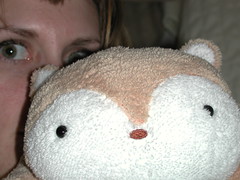January 27, 2006
かわいい!!〜

momotaro and me
Originally uploaded by nattynattyboom.
What is kawaii? And why are the Japanese so obsessed with it? They are obsessed to the point that virtually every corporate logo, every product, and every event is accompanied by a “cute” mascot. One encounters kawaii packaging from delivery services to mobile phone companies, from pharmaceuticals to toilet paper. Kawaii is a cultural institution—even the municipal and prefectural governments each have a kawaii character that graces the pages of their tourist brochures. While grocery shopping one will encounter various portable stereos blasting looped “cute” theme songs for different departments, featuring children singing songs like, “Niku niku niku” (meat meat meat) over a background of pop synthesizers. The “cute” industry is booming and expanding globally. Kawaii is ubiquitous. And irresistible.
I’ve never been the kind of girl who could be entertained by browsing in gift shops, “oohing” and “aahing” over meaningless minutiae. Nothing usually catches my eye. I first realized this when on a class trip to Washington, D.C. After every museum it seemed my friends would get caught up for what seemed like hours inspecting and commenting predictably on every little plastic souvenir.
In Japan this behavior has been refined and spread, until it seems to be a national syndrome. I participated in a kimono festival in Nagahama last year, and from what I observed it could have been subtitled Let’s-Get-Dressed-Up-in-Kimono and-Then-Go-Shopping! Day. After the laborious process of putting on the kimono, all we did was wander around the shopping district and murmer, “ah, kawaii…” at every little Totoro or TarePanda.
It seemed that I was impervious to all these kawaii knick-knacks until now. I’ve always found kawaii fascinating as a cultural phenomenon, but never been driven to actually buy any of it. But last week I bought a stuffed raccoon with a big round head, no neck, tiny ears, no mouth and little bead eyes. He is so impossibly…cute.
The reason I bought him was because of heartache. In the period between leaving Japan for vacation and coming back, I lost many things—my home, my friends, and my boyfriend of four years. My heart was absolutely shattered. On the plane ride back to Japan, my twelve-hour flight was spent feeling like a used tissue, drinking red wine and indulging in the adolescent sentiment of the Shangri-Las and other teenage girl groups from the sixties. Purchasing the stuffed raccoon also had a calming effect. Every time I squeeze him or look into his vacant expression, I forget a little.
Could this in some way explain the kawaii craze that has gripped this nation in its post-war years? In an interview, the executive of Sanrio, Tsuji Shintaro, revealed something terrible. Speaking about conflict in Kosovo he said, seriously, “If only I could come up with a Hello Kitty smart bomb.” As if an expressionless, two-dimensional kitten could help the soldiers cope with the stress of blowing stuff to smithereens. Perhaps this is the dark side of kawaii, a way of forgetting, a way of preoccupying oneself with adorable yet meaningless tchotchkes, thereby freeing oneself of the burden of introspection and analysis.
